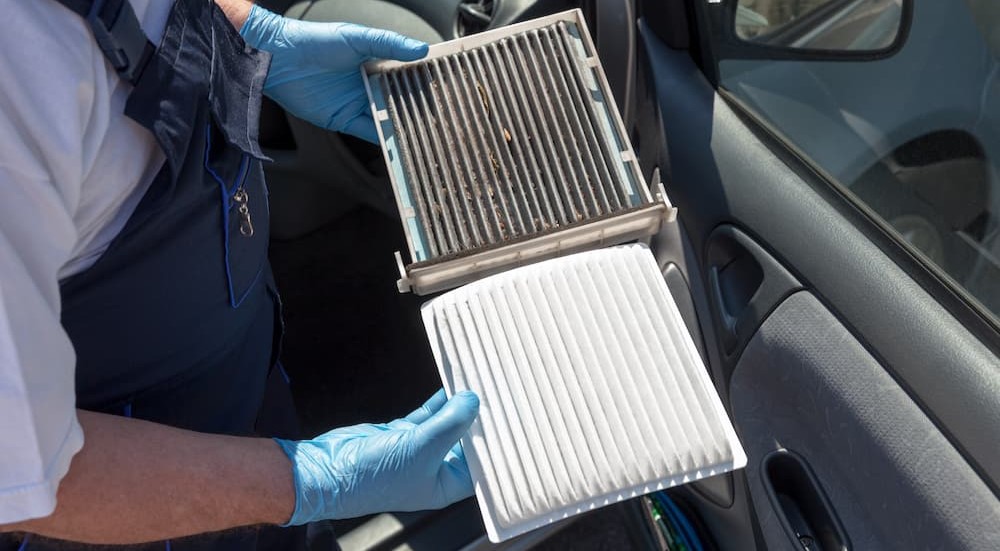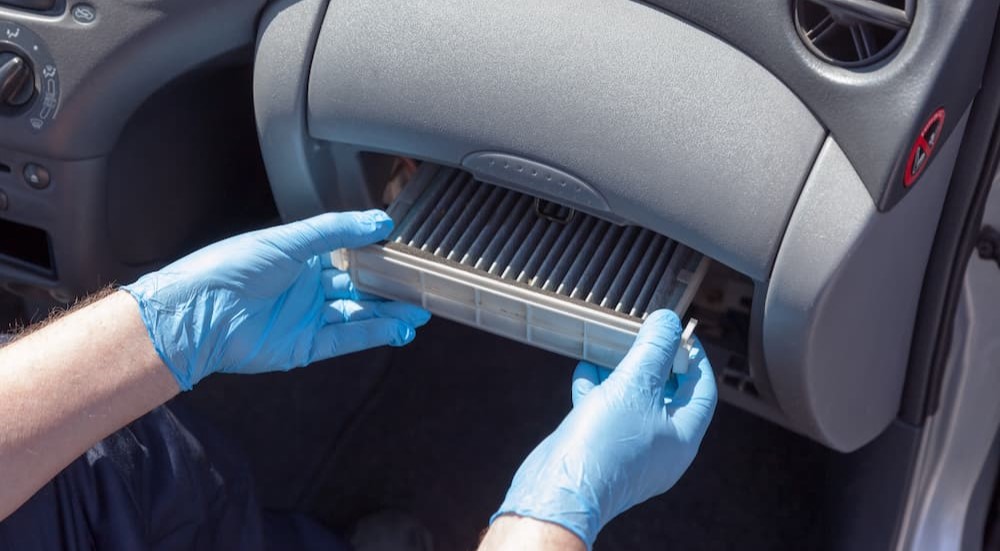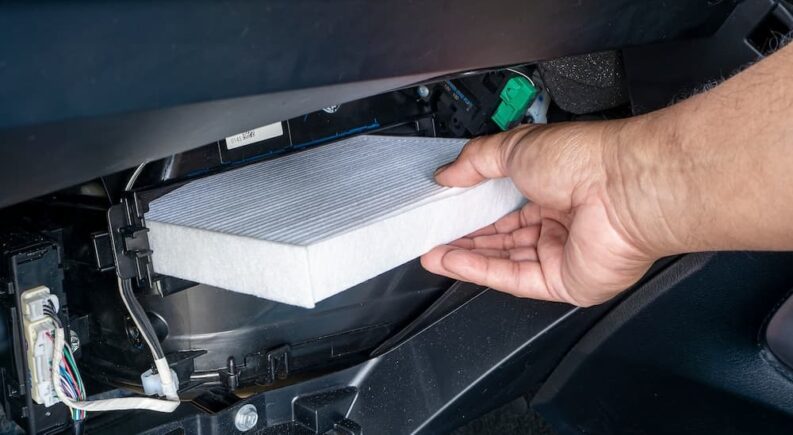You’ve gotten your oil changed, battery checked, tires rotated, fluids topped off… but is anything missing? When you’re completing routine maintenance on your vehicle, it’s important to make sure you check your car’s air filter to ensure it’s still doing its critical job. Many drivers don’t realize what a big role it plays until they fail to replace it and end up in an unfortunate situation.
Cabin air filters are easy to replace, and if you’re unsure of what this maintenance service entails, don’t worry—it’s very straightforward. When it comes to car air filter replacement, it’s imperative not to ignore this essential piece of the complex puzzle that makes up your vehicle.
What Does a Cabin Air Filter Do?
If you’ve ever changed your own oil or gotten it changed by a mechanic, you know that it’s not just the oil that gets replaced; the oil filter also gets replaced because it’s the shield that prevents dirt and debris from entering your vehicle. Well, this is the same idea with your car’s air filter, only that it prevents unwanted pollutants from entering your cabin.
It’s unfortunate, but we travel through more pollution than we realize. From smog in the city to dirt, dust, pollen, and other debris on the highway, all of these particles have the potential to enter your cabin and affect your health. If your air filter is clogged, you run the risk of your allergies acting up with excess pollen entering your airspace, and you may suffer from breathing difficulties due to more dirt and dust getting inside, too. This doesn’t just affect you, however, but also how your vehicle performs.
When your air filter is clogged, your air conditioning and heating have to work in overdrive to help heat and cool your cabin. This can take a big toll on your vehicle, and in some cases, it can cause your car to overheat and burn up your engine. Not only does this add extreme stress to your day, but also an expense that you likely didn’t plan for, which is but one reason why replacing your car air filter is so essential.
The quality of your ride is affected in many ways, especially when it comes to your comfort. The last thing you want is for a foul odor to waft its way through your cabin, but this is a reality when your cabin air filter isn’t working properly. Another risk to consider is your defroster not doing an adequate job clearing your windshield, which can result in poor visibility. This is a risk you simply can’t take, especially when safety is a top priority for you, as well as other travelers.
As you can see, a car’s air filter does more than just shield you from the pollutants of everyday travel—so if you want to ensure a safe and comfortable ride quality, you’ll want to replace this component regularly.

How to Replace Your Cabin Air Filter
Replacing your car’s air filter is quick and easy. It’s a good idea to have a screwdriver handy, although in most cases, you’re able to complete this task without any tools necessary. Be sure to grab the correct air filter for your particular model, and if you’re unsure, consult your owner’s manual. Then, follow the steps below for proper installation:
- Typically, the car air filter is located behind the glovebox, so this component will need to be removed before you begin. This is usually straightforward, and the directions can be found in your owner’s manual. In most vehicles, pressing a button to release the glovebox is all that’s required in order to gain access to this filter.
- You’ll notice the air filter nestled inside. Remove this and clean out any dirt and debris that may be found in the areas surrounding it. You may even want to take a small vacuum to get to some of the hard-to-reach spaces.
- Take the new air filter and install it, making sure that the arrows point the correct way to direct the airflow properly.
- Replace the glovebox and ensure that it’s secured.
In only four steps, you’re on your way to your next destination, enjoying cleaner air inside your cabin, as well as enhanced performance. Although this is quite a simple procedure, if you’re unsure, don’t be afraid to ask questions or get assistance, either from the auto parts store where you’re purchasing the part or from your mechanic.
Signs It’s Time to Change Your Cabin Air Filter
Typically, your car’s air filter will need to be changed out about every 15,000 miles or so. This will depend on your particular vehicle, as well as your driving habits. You can consult your owner’s manual if you have questions. There are signs, however, that it’s time to replace this important part, so it’s highly advised not to ignore what your vehicle is trying to tell you. These signs may include:
- Poor airflow out of your vents, whether you’re looking to heat your car on a frigid winter morning or cool off on a hot summer’s day.
- Bad odors permeating your car; you may think that the odor may be surrounding you outside your vehicle, but in fact, it may be inside, following you to all your destinations.
- Whooshing or whistling noises out of your air vents when the HVAC system is running.
If you notice any of these symptoms, it may be time to take a closer look at your car’s air filter. These are common problems associated with a clogged filter, which is why it’s better to replace it now before things get worse. After all, you don’t want to worry about reduced visibility, poor air quality, or decreased performance with your vehicle.

FAQs About Air Filter Replacement
You may have some questions about this maintenance service, and you’re certainly not alone. Let’s dive into some of the most commonly asked questions about car air filter replacement; this way, you’ll be more confident in completing this service…
Q) Does a Cabin Air Filter Affect Gas Mileage?
A) You may not realize it, but when any part of your vehicle is working overtime, this has the potential to affect fuel efficiency. Remember, your HVAC system may have a more difficult time pushing air into your cabin through a clogged filter; this results in the system working harder, thus affecting how your vehicle runs.
Q) How Long Does It Take to Replace a Car Air Filter?
A) These simple steps should take no longer than about 15-20 minutes to complete. The longest part of the process will most likely be cleaning out the surrounding area to ensure all dirt and debris has been removed.
Q) How Much Is a Car Air Filter?
A) This part can be quite inexpensive; however, as with anything, you’re able to choose which type of part you desire, with higher-quality air filters costing a bit more. On average, you can end up spending anywhere between $20-$50 on a car air filter.
It may be clear to you now that car air filters are quite important to the overall quality of your ride. If you’re in need of a new filter, don’t wait; either stop by an auto supply store and pick one up or schedule an appointment with your mechanic to get this handled. When it comes to your vehicle, preventative maintenance is imperative, so don’t skip the small stuff; even the smallest components have big jobs to do.

